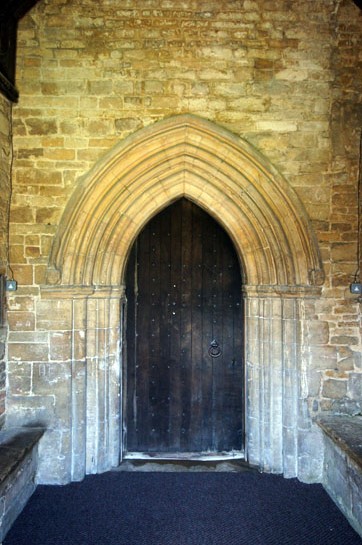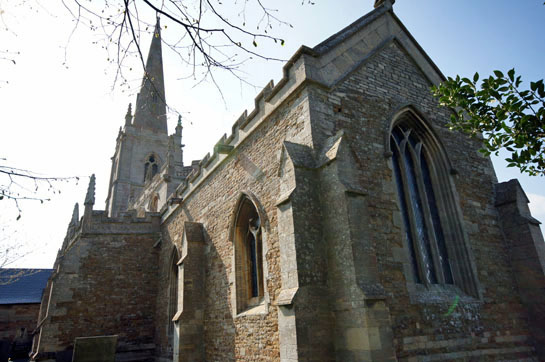|
Alphabetical List |
|
|
|
|
|
|
|
County List and Topics |
|
|
|
Please sign my Guestbook and leave feedback |
|
|
||||||||||||||||||||||
|
had a penchant for such friezes and I have done considerable research of my own concerning those in the Rutland, East Leicestershire and South Lincs area - click here to see it. Also check out the stunning carvings at Brant Broughton in Lincolnshire. Some of the carvings at Great Gonerby are very sophisticated and clearly laden with symbolism that is difficult to fathom today. As with many cornice friezes and carvings, it would be a mistake to assume that they date from the same period as the parts of the church that bear them. When we look at the clerestory we see battlements, shields and pinnacles that are reproduced on the earlier aisles: someone had decided to tart up the rooflines of the aisles when the clerestory was added and this is a familar story in the East Midlands - see Edenham for another example in Lincolnshire. |
 |
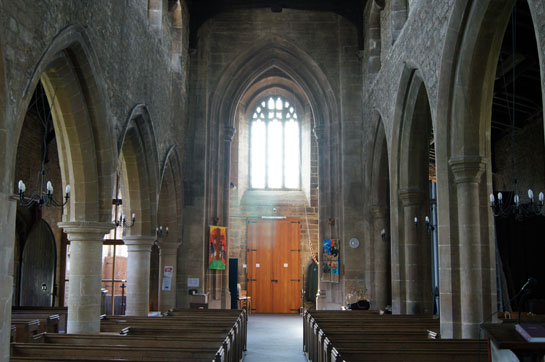 |
|
Left: Looking east. Note the taller and later north arcade. Like many churches in the East Midlands, Great Gonerby’s interior is “scraped” of any paint of any paint or whitewash. This is not to everyone’s taste but I think it suits the ironstone of Great Gonerby well. Right: The west end. The use of a very tall Perpendicular style tower arch allows the west window to pour into the nave - a very attractive device. |
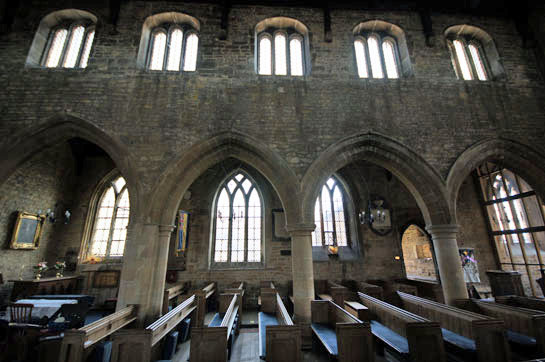 |
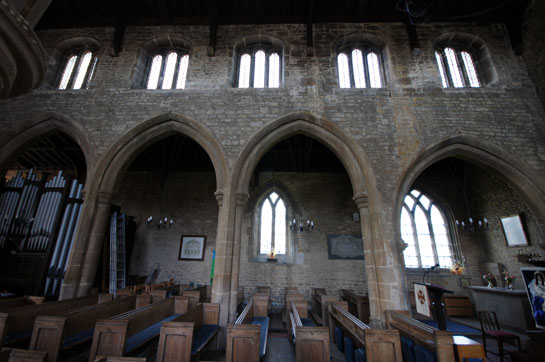 |
|
Left: The south arcade. Note the left hand, easternmost, arch which is taller than the others. Right: The north arcade is substantially taller as well as later. Here the easternmost arch is lower - but perhaps comparable in size with its southern counterpart. This would reinforce the idea that the church had transepts before the aisles were built. |
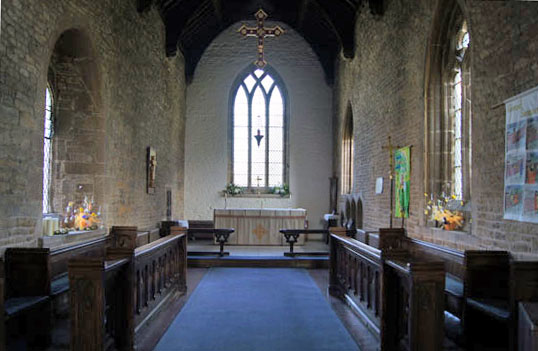 |
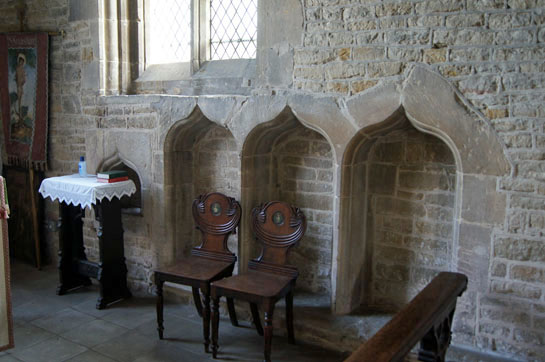 |
|||||
|
Left: The plain chancel. Right: The triple sedilia with its matching aumbrey cupboard to its left. These ogee-shaped arches - convex and then concave - are clear evidence of a Perpendicular period rebuilding. |
||||||
 |
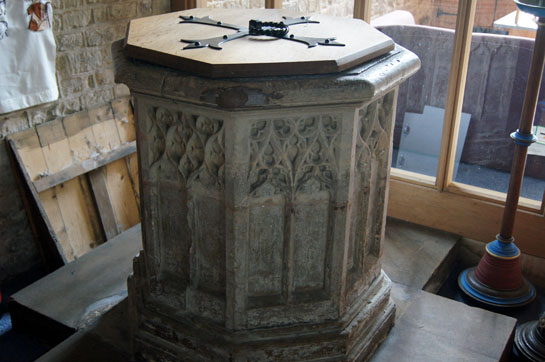 |
|||||
|
Left: The late Norman capitals on the eastern bay of the north arcade that give away the likelihood that there were transepts here before the aisles. Right: The font is from the Decorated period. Each side of the octagon is different and seems to represent a Decorated period window pattern with the elaborate tracery characteristic of that period. Pevsner styled it as being “like a pattern book”. |
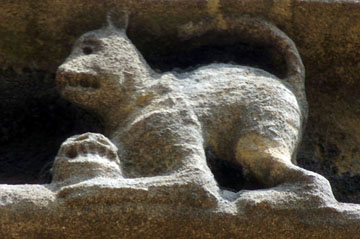 |
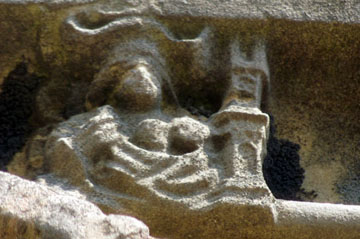 |
||||||||||||||||||||||||||||||
 |
|||||||||||||||||||||||||||||||
|
It is Great Gonerby’s frieze that captures the imagination...but knowing what it is that these carvings represent is quite another matter. The creature on the left seems to have a skull between his paws. The figure in the centre appears to be holding some sort of tall artifact in his hand. Is it a symbolic tower? Right: This looks to be an angel reading from a book. In the East Midlands religious imagery on cornice friezes is surprisingly rare. |
|||||||||||||||||||||||||||||||
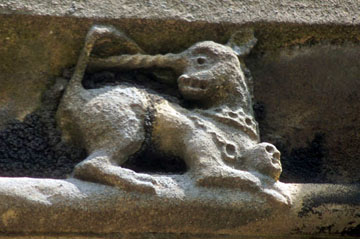 |
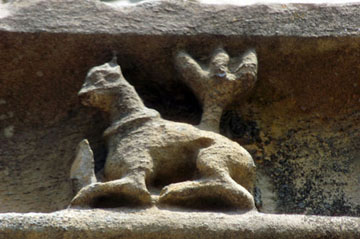 |
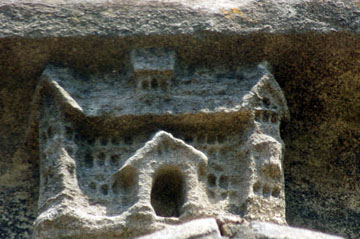 |
|||||||||||||||||||||||||||||
|
Left: Here we can identify a unicorn without difficulty. Around his neck, however, is a chain with a skull. What does this mean/ Well, the unicorn often symbolised God’s incarnation in Jesus. But why the skull? Centre: Another fabulous creature. Is that a tree behind him? Right: This is the carving that intrigues me most. Obviously it is building. With so many windows it is a veritable palace. Surely the carver had somewhere specific in mind here? |
|||||||||||||||||||||||||||||||
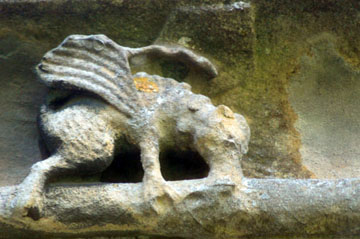 |
|||||||||||||||||||||||||||||||
 |
|||||||||||||||||||||||||||||||
 |
|||||||||||||||||||||||||||||||
|
Left: This winged creature seems to be pecking at the ground. Centre and Right: I think these must be dogs of some sort. Note the chains about both of their necks. This is something the carver here seemed to love to do. Are we to think of them literally as canine neckware? Or could the carver have been satirising some of the local dignitaries with their chains of office? |
|||||||||||||||||||||||||||||||
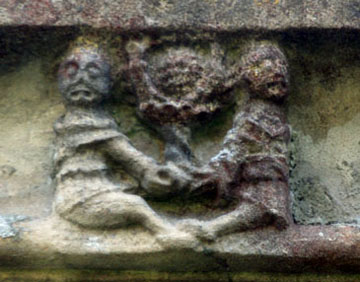 |
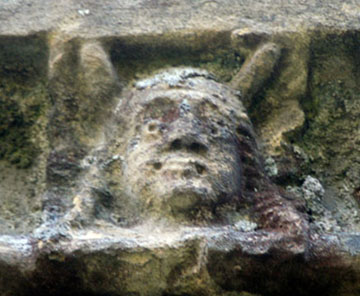 |
 |
|||||||||||||||||||||||||||||
|
Left: This looks like a man and a woman but it’s hard to be sure. Neither looks very happy! Between them they hold what seems to be some sort of plant with a twisted stem. Maybe. Centre: This seems to have a couple of legs behind his head. Surely not? Right: The Gonerby carvings have survived well but this is is a rate headless one. He has a scaly mane and bizarre feathery feet. Then there is a tree behind him or a set of antlers growing from his back. Take your pick! |
|||||||||||||||||||||||||||||||
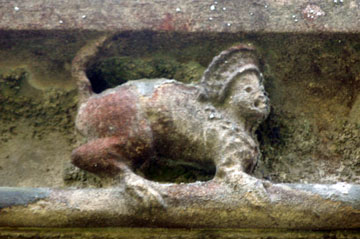 |
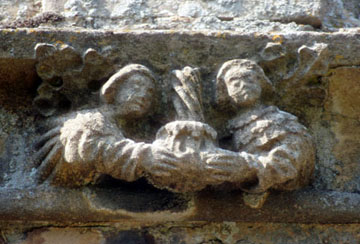 |
 |
|||||||||||||||||||||||||||||
|
Left: This creature is less grotesque than most. That headdress looks like a woman’s to me - maybe even a tiara or cornonet of some sort. And there’s that chain around the neck again! Centre: Two very human and un-grotesque men here with a considerable amount of detail. There is, again, what seems to be some sort of pot but we can only speculate what that twisted stem is meant to represent. Right: This is another odd one. The creature has the look of a bird but with an animal’s head. The wings are very grand and stylised. |
|||||||||||||||||||||||||||||||
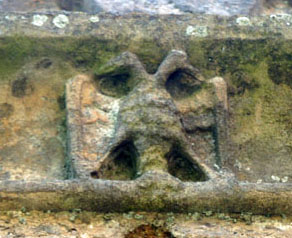 |
|||||||||||||||||||||||||||||||
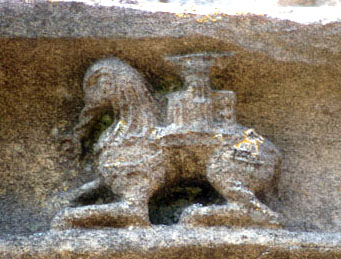 |
 |
||||||||||||||||||||||||||||||
|
Left: This is another curious one. The body is like that of a horse, but the head is not. In fact, if you look carefully he has a proboscis-like protrusion which may mean that this was meant to be an elephant. There is quite a lot of carved detail around his body and also upon the burden upon his back. Centre: A bird with two heads looking in opposite directions. Right: I had thought that this was a creature with a long horn protruding from the back of his head but in closer examination I think it is a long tongue emanating from his mouth. |
|||||||||||||||||||||||||||||||
|
I can’t reproduce the whole frieze here but these carvings are the best and most interesting. Some seem to be straight out of a Mediaeval Bestiary. These books described all kinds of creatures, real and imaginary, and ascribed all manner of symbolism to them. Our carver would certainly not have had access to a book that were owned only by the very wealthy so perhaps we are seeing our carver’s imagination filling in the gaps. Some of the human images are interesting for another reason: they look to be narrative and drawn from events. Then there is the issue of the chains around the necks. I am opposed in general to the pointless pursuit of trying to “explain” what was going through the mediaeval mind. So it is with some trepidation that I advance very tentatively the theory that they are indeed satirical. Satire was far from unknown in mediaeval carving and our sculptors could rely on ambiguity, perhaps, to protect them from retribution. You can see some very pithy examples on, for example, the bench ends at Brent Knoll Church in Somerset. I think that this frieze is an unusual mixture of the fantastic and the very real. You only have to look at that carving of what is surely a very contemporary house. This theme of the contemporary is particularly obvious on two of the carvings on the corners of the friezes. I am, again, always a bit sceptical of the unprovable popular fantasy that carvings of human heads are invariably those of real people - although some almost certainly are, particularly inside churches. But these carvings at Gonerby are clearly figures of authority with chains of office - yes those again - around their necks. Did the carver depict the dignitaries with one hand and lampoon them with the other? One of them is holding a ball in each hand. They clearly mean something - but what? You decide! |
|||||||||||||||||||||||||||||||
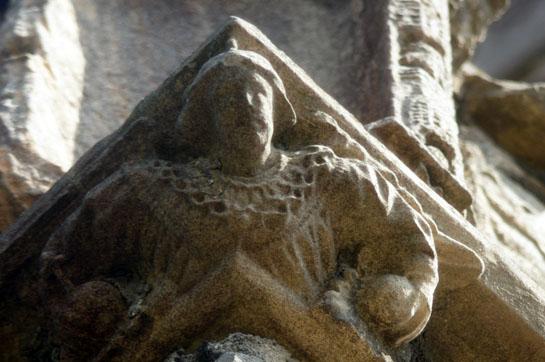 |
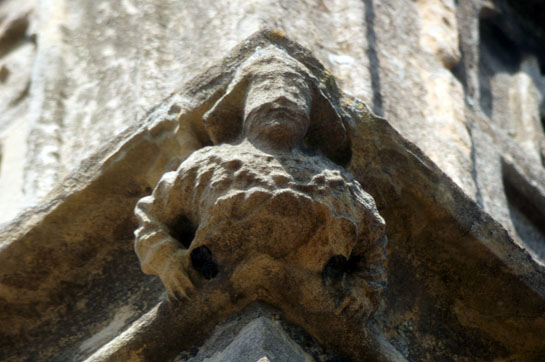 |
||||||||||||||||||||||||||||||
|
“Authority figures”, Great Gonerby Church. The character left is a magisterial figure, but he has a ball in each hand. His clothing has been finely carved with lots of detail. The gentleman on the right also has a chain of office. In both cases the heads have survived weathering sufficiently for us to see them as real people with discernible facial features. They are real treasures, in fact, because the few surviving drawings or paintings of the period tend to be in exaggerated, even fantastic, style and only of the very famous. Who were these satraps of Great Gonerby? |
|||||||||||||||||||||||||||||||
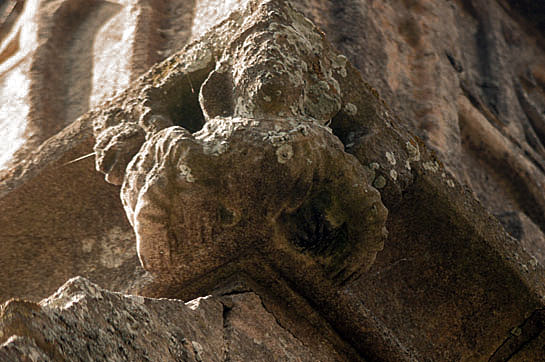 |
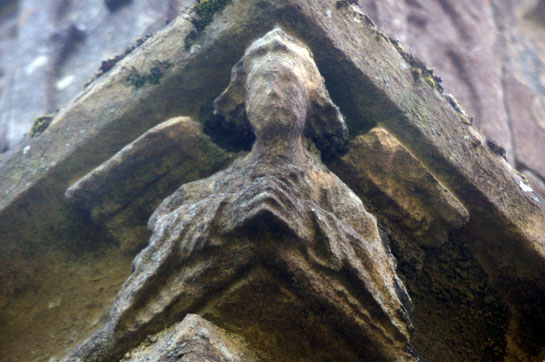 |
||||||||||||||||||||||||||||||
|
Left: Another authority figure with chain. This ones seems a little puffed out - a self-important man perhaps. Look close above each of his elbows and there are weathered carvings that look like they are animals or grotesques. What can they mean? Right: This, on the other hand, is an angel figure of some sort. Again, though, there is something human - even pensive - about the face. |
|||||||||||||||||||||||||||||||
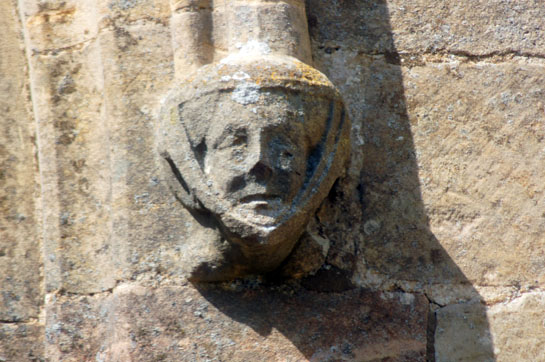 |
|||||||||||||||||||||||||||||||
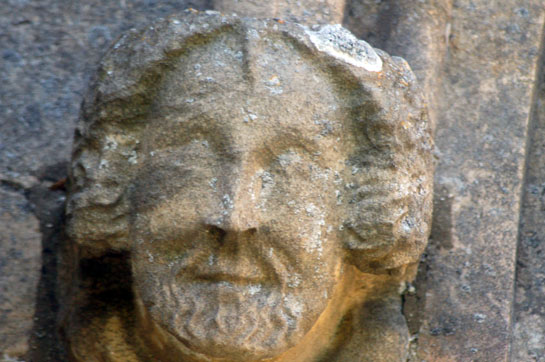 |
|||||||||||||||||||||||||||||||
|
The “human” theme continues with this pair of label stops. The lady on the left has the most human face I have ever seen carved on a church exterior. I find it quite moving. Women’s headdresses should and sometimes are an invaluable guide to dating. This example, however, is not one such as would have been worn by the aristocracy so we can’t use the ploy of looking at the images on (dated) monuments and brasses to fix headwear to a particular period. I think c16 is right for this example, however. I imagine that the man on the right with the beard, dodgy hairstyle and kindly face was her husband. |
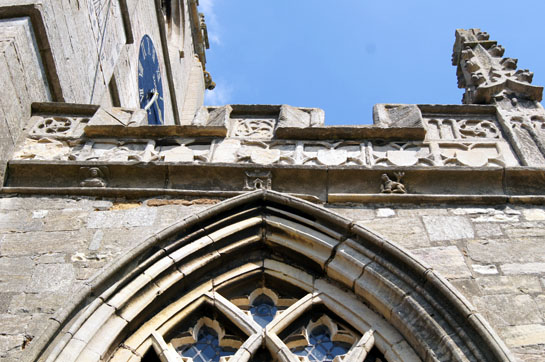 |
|||||
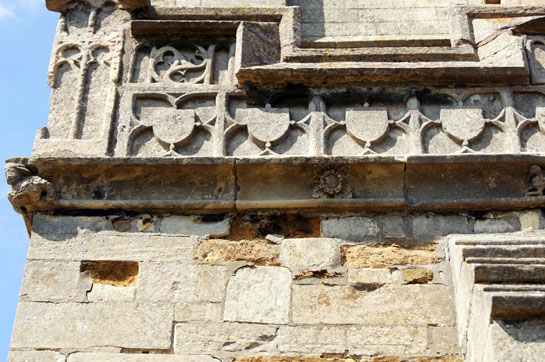 |
|||||
 |
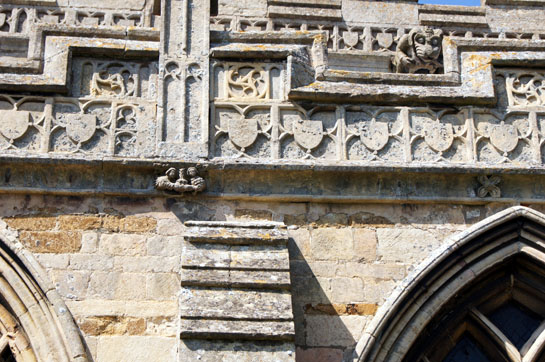 |
||||
|
Some views of the cornicing and the battlemented parapets on the church. As is so often the case, the parapeting is almost certainly a Perpendicular addition to an earlier structure. Books and Church Guides tend to be silent on the dating of carvings, rather implying that they are contemporary with the walls that support them, but this is often not so. At Great Gonerby, as at so many mediaeval churches, the addition of a clerestory and the expansion or addition of aisles was the last major structural phase. When the parapet is uniform and includes the clerestory it doesn’t take a genius to work out that the decoration over the whole church probably dates from then too! We don’t know when the cornice frieze was added but as it exists on the Perpendicular style north aisle as well as the south then we can assume that it too was added quite late in the day. We can say the same about the grotesques that adorn the cornices as well. Like everything else at Gonerby, the quality is high. These gargoyles (and remember that the word strictly speaking applies only to carvings associated with water drainage) will have been installed when the roofs were leaded. Watertight leading allowed the slopes of roofs to be less steep and for aisles to be wider, but parapets meant that drainpipes needed to be installed to allow the water to escape. So parapets, gargoyles, leading and aisle widening seem to me to have been a considerable industry in the fifteenth century. |
|
|
||||||||||||||||
|
The Plungar Connection |
|
It is thirteen miles west from Great Gonerby on the outskirts of Grantham to Plungar in the Leicestershire countryside. In 2023 my friend Bonnie Herrick was flashing through photographs on her laptop when I was brought up short by some photographs she had taken of a frieze on the tower at Plungar Church, I knew immediately and without any shadow of a doubt that they were carved by the same man who had carved the friezes at Great Gonerby. The photographs below are mainly hers because when we visited together it was a foul day. |
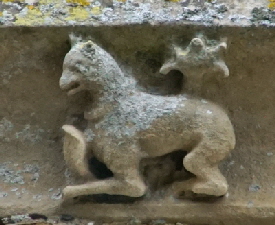 |
 |
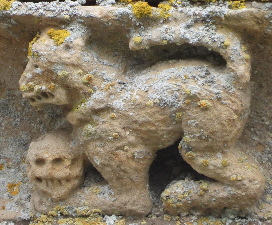 |
 |
||||||||||||||||||||||
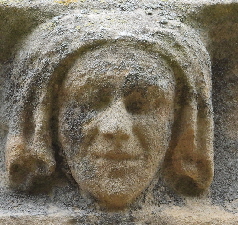 |
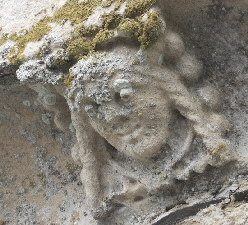 |
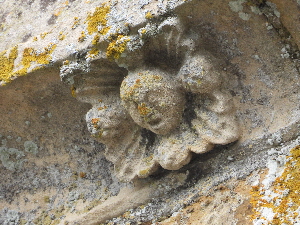 |
 |
||||||||||||||||||||||
 |
 |
||||||||||||||||||||||||
|
Footnote - Musings on Great Gonerby’s Carvings |
|||||||||||||||||||||||||
|
If anyone wants to know how I decide which churches to “write up” on this site I am hard-pressed to answer. Recent visits loom large in the mind, of course. Sometimes I decide that a particular county is poorly served and decide to rectify it. Sometimes if I have done a particularly long page about a very complex church I decide to tackle a small simple church just to give me a bit of a breather. Whim, however, is a big factor. Great Gonerby had a large element of whim when I chose it, added to my interest in cornice friezes in the East Midlands. When I assemble the photographs for a particular church, or during the process of writing, puzzles and insights often come emerge and Great Gonerby falls into that category. Much time is, in my view, wasted, in trying to get into the minds of mediaeval carvers to “explain” their work. It’s noble work but without enormous expenditure of time and imagination the result is usually just speculation, often reflecting a person’s own preoccupations. You would be amazed at the number of seemingly innocuous carvings that are deemed to be sexually exhibitionism, for example! It is frustrating that we can’t get inside the fertile imaginations of the carvers but, except in cathedrals and abbeys that employed the very best of artists, I think we generally have to admit defeat. In fact, I believe many, perhaps the majority, are the whims of the individual carver. Great Gonerby’s cornice frieze, however, has some scenes that are obviously designed to convey deeper meaning, no matter that is is opaque to us. Most of them are not “fantastic” and there are few that don’t have some quirk - such as the chains around the beasts’ necks - that have subtle significance to the people of the time, but which are lost on ourselves. It is finely carved and enormously interesting. I have suggested - no more than that - that there is satire in those carvings. That is reinforced by what I call the “authority figures” on the corners of the cornices. It seems to me that these were people known to the carver and his guild, and the local people would have known them too. Without the benefit of the paint that would originally have been there and with weathering have taken its toll, we can’t make out as much detail as I would like. At least two of the figures, however, seem to have symbolism that is personal to them. Whether it is satirical or just symbolic of their positions in society we cannot know but there seems to be at least some element of caricature. Then there are the label stops. Most label stops are plain boring. Most human heads could be representations of real people as many believe but they are generally anodyne and instantly forgettable. The two faces shown above, however, are in a different class and surely, again, real people. We can speculate that they were yeoman landowners or wealthy merchants. Whoever executed them was capable of conveying humanity and emotion, of creating a likeness and not just a generic representation of the human face. He was a craftsman and not, as on many of the churches, a stonemason carving a few external decorations. Putting all of this together, Great Gonerby’s carvings are of more than normal interest. Any Great Gonerbian who has some spare time might profitably look at the local history archives and draw some conclusions. I am convinced that the carvers at this church were not just using their vivid imaginations: they had stories to tell. |
|||||||||||||||||||||||||
|
|
|||||||||||||||||||||||||

